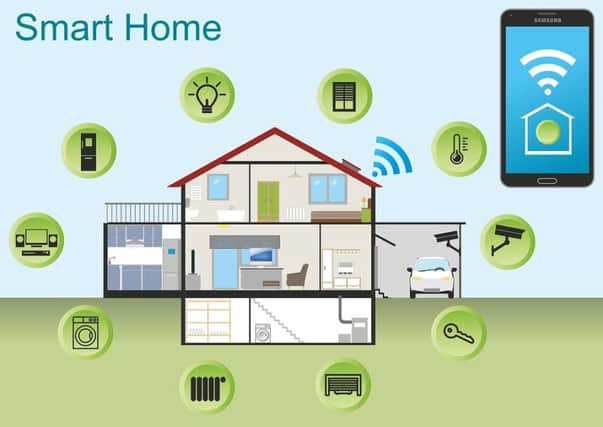How to turn your house into the smarthome


The idea of a house that is aided by artificial intelligence has been at the forefront of our national psyche for decades.
The concept of a smarthome has been aided by recent strides in innovation and the realisation by tech entertainment giants that their products could serve more of a purpose than just during our down time.
Advertisement
Hide AdAdvertisement
Hide AdAmazon has already stolen a march with it’s Alexa technology, but fellow internet behemoths are thought to be closely behind with products of their own.
We take a look at just a few of the ways that technology can make your home interconnected and smarter – some are already widespread, and others haven’t made the mass market yet.
Heat control
Many experts are now looking on connectivity in the home as the ‘fourth utility.
How fitting that other utilities are now able to be controlled from phones, tablets and other devices to ensure that homes are kept as energy efficient as possible.
Interactive, interconnected thermostats are just the latest way that technology is being used to try and control fast-rising household builds.
Hive and Nest, the two market leaders, are becoming more and more popular, with the set-up allowing users to change their temperature before they come home on a cold day, or to enjoy a more accurate timing system than on traditional thermostats.
These thermostats are designed to make your home smarter and cheaper to run by working out and adapting to your heating patterns.
While glitches are still reported by testers, most give glowing reviews to the user-friendly new way of changing their heating.
Voice Activation
Advertisement
Hide AdAdvertisement
Hide AdA classic staple of the smarthomes featured in fiction and futurology, it is often assumed that to be able to control your home, you would need to address technology directly.
To call Alexa the market leader in smarthome voice activation technology is to dramatically understate it.
The Amazon-owned and conceived product is designed to give information through voice interaction, with news and travel among the orders most frequently given.
It can also play music, interact with other smarthome devices like thermostats, and can even order food.
A drawback is that Alexa can only currently recognise English and German, and it has been anecdotally reported that the technology is ill-suited to Scottish accents.
Google Home is the tech monolith’s answer to Alexa, but it has yet to gain any meaningful ground against its rival.
Other home tools
We spoke to Erik Hansen, who is the owner and Director of Cleverhouse, a company which specialises in Home Automation and Smart Wiring, about how technology can aid the home.
“It’s all about the connection,” he said.
“I absolutely agree that connectivity is the fourth utility, and one of the main challenges going forward is ensuring that broadband coverage is as good as it can possibly be.
Advertisement
Hide AdAdvertisement
Hide Ad“We find doing work on larger houses or those that are a little older and have thicker walls, that it is very easy for signals, even within a house, to be weakened.
“A lot of our work is on Smart Wiring, We would prefer if new builds as standard were wired for the future.”
Erik works with clients of all budgets on everything from media rooms to allowing people to control their blinds and lighting remotely.
He believes that it is the development of tablets and phones, with their agreeable user interfaces, that have made the smarthome concept more mainstream.
The Future
Erik is a firm believer in the Internet of Things, a formerly abstract concept that has taken on new prominence as debates on the role of Artificial Intelligence in a new economy rage.
At its most simple, the concept of the Internet of Things is that all our devices, from household appliances to medical equipment, would all be interconnected.
It’s a concept Erik is enthused about.
He added: “In the future, if the connectivity in the country is rolled out properly, there is so much good that could be done by smart homes.
“Think of a smart fridge that remembers when and where from to order your weekly shop – and has an interface for you to track your food budget and usage.
Advertisement
Hide AdAdvertisement
Hide Ad“It’s not just entertainment and easy to use appliances, though. We have an ageing population and a social care crisis.
“It would be so much easier to keep vulnerable people in their homes if they were fitted with smarthome technology, right down to medical equipment, that could make it so much easier to care for and monitor them.”
Whatever the future holds, it is clear that with the right investment in infrastructure and proper consumer testing, the home of the future could be in the present very soon.